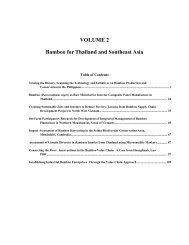WBC-VIII-Vol.4 – Resources – Forestry, Plantations and ... - BambuSC
WBC-VIII-Vol.4 – Resources – Forestry, Plantations and ... - BambuSC
WBC-VIII-Vol.4 – Resources – Forestry, Plantations and ... - BambuSC
Create successful ePaper yourself
Turn your PDF publications into a flip-book with our unique Google optimized e-Paper software.
that although D. br<strong>and</strong>isii has a higher potential yield (see Table 23), the relative performance of B. vulgaris in<br />
terms of culm weight is better (see Table 30). It was observed that the culm production of B. vulgaris was the<br />
most vigorous in terms of culms per clump.<br />
D. Br<strong>and</strong>isii, followed by D. hamiltonii <strong>and</strong> D. strictus, show better overall performance than the other species<br />
in Kakamega. B. tulda ranks fifth; despite its relatively low culm weight <strong>and</strong> height, the species shows a high<br />
potential yield due to the number of culms per clump.<br />
T. siamensis is a small species but it showed very good relative performance in terms of culm height <strong>and</strong> number<br />
of culms per clump. However, the culms of this species are naturally small, <strong>and</strong> hence it ranked poorly in terms<br />
of potential yield. T. siamensis was planted using a spacing of 5m x 5m in the trials. However since it is small<br />
bamboo it may be planted at more proximate distances in order to maximize the biomass yield per hectare. The<br />
optimal plant spacing for T. siamensis is 4m x 4m (Dransfield & Widjaja, 1995). Had there been management<br />
<strong>and</strong> harvesting on the site, this species might have performed much better.<br />
Species<br />
Rank<br />
Table 25: Species to Site Matching for Kakamega (Lake Region)<br />
Overall<br />
Performance<br />
Ranking Criteria: Exotic Bamboos in Kakamega (Lake Region of Kenya)<br />
Site Observation Analysis Benchmark Comparative Analysis<br />
Potential Yield<br />
(EY)<br />
Culms per Clump<br />
(AC)<br />
Culm Weight<br />
(DM %)<br />
Culm Height<br />
(H %)<br />
1 B. vulgaris D. br<strong>and</strong>isii B. vulgaris B. vulgaris T. siamensis<br />
2 D. br<strong>and</strong>isii D. hamiltonii T. siamensis D. br<strong>and</strong>isii B. vulgaris<br />
3 D. hamiltonii B. vulgaris D. hamiltonii D. strictus D. hamiltonii<br />
4 D. strictus D. strictus B. bambos D. hamiltonii D. strictus<br />
5 B. tulda B. tulda D. membranaceus D. membranaceus D. br<strong>and</strong>isii<br />
6 T. siamensis D. membranaceus B. tulda T. siamensis D. membranaceus<br />
7 D. membranaceus B. bambos D. br<strong>and</strong>isii B. tulda B. tulda<br />
8 B. bambos T. siamensis D. strictus B. bambos B. bambos<br />
If the purpose of the plantation is to obtain the highest culm yield in terms of tons per ha, then the selection of<br />
species to be recommended are D. br<strong>and</strong>isii followed by D. hamiltonii. However, these are merely<br />
provisionally recommended species. Culm yield, weight, <strong>and</strong> height are not the only criteria for selecting<br />
species for a bamboo plantation. It is essential to have a market <strong>and</strong> product or intended use for the bamboo. If<br />
the intended use is bioenergy, then planting species with the highest annual yield per hectare is recommended.<br />
However, species with a lower yield per hectare may be more suitable for splitting, weaving <strong>and</strong> basketry, which<br />
may have a ready market.<br />
Muguga’s altitude <strong>and</strong> climatic conditions are comparable to those of Lari. Species performance in Muguga can<br />
therefore be used as a basis for selection of species for the project sites in Lari. Olenguruone lies at a higher<br />
<strong>VIII</strong> World Bamboo Congress Proceedings Vol 4-135




